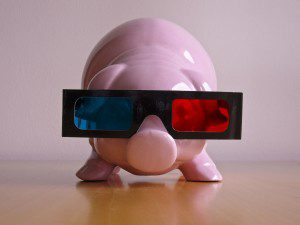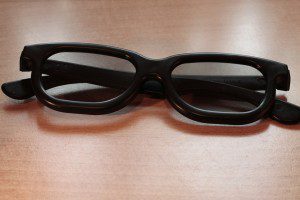
Before we can address how 3D movies work, we need a brief review on how we experience depth perception in our everyday life. Remember that our retinas are flat surfaces which light stimulates, so how do we go from 2 flat retinas to a single 3D world? Understanding this will allow us to understand how we can go from a flat screen to a 3D movie.
Binocular Disparity
We are able to get some sense of depth perception with just one eye (using monocular depth cues such as relative size and linear perspective) but this isn’t quite as good as the sense of depth we get from using two eyes. You can test this out by closing one eye while playing a game of catch with a friend. While you can still judge depth with one eye closed, you’ll probably find catching something noticeably harder.
Like most other predators, humans have both eyes on the front of their heads, allowing the visual field of one eye to overlap with the other. Your left eye sees much of the same stuff that your right eye sees. This isn’t simply for redundancy; it allows a powerful increase in depth perception because each eye sees a slightly different angle of the same thing. Our brains can then determine the approximate depth of objects based on how different these two retinal images are. To test this out, hold a pencil in front of you, just a few inches from your nose, then close one eye at a time while looking at it. You’ll notice that the pencil “jumps” back and forth. When your left eye views it, it’s on the far right of the image, while when your right eye views it the pencil is on the far left of the image. When both eyes are open, this disparity tells your brain that the object is very close to you.
In contrast, if you hold the pencil at arm’s length and then switch eyes, you’ll notice that the pencil’s apparent movement is smaller. Get a friend to hold a pencil on the other side of the room and when you switch eyes it won’t really appear to move at all. When both eyes see the pencil in roughly the same place, this tells your brain that it is farther away.
So let’s get back to what all this means for 3D movies. What 3D movies need to do in order to create a stronger sense of depth is provide each eye with a slightly different version of the film. This is done by recording the movie using two camera lenses simultaneously, spaced just a few inches apart. This essentially creates “left eye” and “right eye” versions of the movie. By showing each eye its own version of the film later, the brain will automatically combine these images, creating a 3D effect.
How the Glasses Work
If we could just each put on goggles that showed each eye its own version of the film, it would be simple to see how the 3D movie works. Each eye would get its own screen showing one of the versions. If you had a ViewMaster toy as a kid, this is how it worked, with each eye seeing a slightly different slide image (this type of device is known as a stereoscope). But when it comes to theaters, things get a little more complicated. How can we show different versions of the film to each eye with only one screen?
If you’ve looked at an old 3D movie without the glasses on, you can see that there actually are two different versions of the film playing on the screen. The original way of doing this, known as anaglyph 3D, was to use colored filters. By making one version of the image red and the other greenish/blue, then filtering the light through tinted glasses, early 3D movies were able to selectively send some information to one eye and different information to the other.
You can see this if you look at a 3D picture designed for red/blue glasses, such as the one here.
Notice how the parts of the image meant to appear closer have greater disparity between the red/blue colors, while the parts of the image that are farther away are more similar (compare the hexagonal section and the spherical section of the satellite above).
While this technique works, these lenses mess with the colors in the film. If you’ve seen a 3D movie recently, you know that red-cyan lenses are no longer used. But the basic technique is still the same; showing two versions of the film on a single screen and then selectively allowing each eye to see only one of those versions. So how do non-colored glasses manage this?

The answer is that modern 3D movies accomplish this by using glasses with polarized lenses. The glasses have two polarized lenses which each allow different light through (usually left-handed circular polarization and right-handed circular polarization) allowing each eye to see a different version of the film. This method has the advantage of no longer distorting the colors of the film, creating a more realistic sense of depth. So hopefully next time you go see the latest blockbuster in 3D you’ll have a greater understanding and appreciation for the techniques behind the entertainment.


2 Comments on “How do 3D Movies Work?”
Pingback: Depth Perception | Psych Exam Review
Pingback: Sensation & Perception Resources | Psych Exam Review